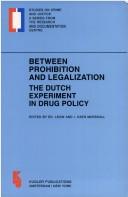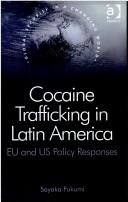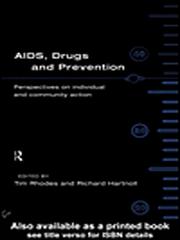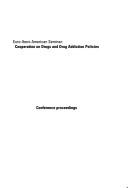| Listing 1 - 10 of 40 | << page >> |
Sort by
|
Book
ISBN: 3922498469 9783922498469 Year: 1989 Volume: 41 Publisher: Freiburg: Max-Planck-Institut,
Abstract | Keywords | Export | Availability | Bookmark
 Loading...
Loading...Choose an application
- Reference Manager
- EndNote
- RefWorks (Direct export to RefWorks)
Narcotics, Control of --- Congresses --- Drug control --- 343.966 --- 343.966 Drugs --- Drugs --- Drug enforcement --- Drug law enforcement --- Drug policy --- Drug traffic --- Drug traffic control --- War on drugs --- Vice control --- Government policy --- Congresses. --- Drug control - Europe - Congresses.
Periodical
ISSN: 16833252 08735379 Year: 1996 Publisher: Lisbon : European Monitoring Centre for Drugs and Drug Addiction,
Abstract | Keywords | Export | Availability | Bookmark
 Loading...
Loading...Choose an application
- Reference Manager
- EndNote
- RefWorks (Direct export to RefWorks)
Drug control --- Drug enforcement --- Drug law enforcement --- Drug policy --- Drug traffic --- Drug traffic control --- Drugs --- Narcotics, Control of --- War on drugs --- Government policy --- Vice control --- Drug control. --- Europe --- EU countries --- Euroland --- Prevention --- European Union countries.
Book
ISBN: 1003169619 1000539474 1000539407 0367770555 Year: 2022 Publisher: London ; New York, New York : Routledge,
Abstract | Keywords | Export | Availability | Bookmark
 Loading...
Loading...Choose an application
- Reference Manager
- EndNote
- RefWorks (Direct export to RefWorks)
This volume presents an interdisciplinary analysis of the practice of disappearances in Mexico, from the period of the so-called 'dirty war' to the current crisis of disappearances associated with the country's 'war on drugs', during which more than 80,000 people have disappeared. The volume brings together contributions by distinguished scholars from Mexico, Argentina and Europe, who focus their chapters on four broad axes of enquiry. In Part I, chapters examine the phenomenon of disappearances in its historical and present-day forms, and the struggles for memory around the disappeared in Mexico with reference to Argentina. Part II addresses the political dimensions of disappearances, focusing on the specificities that this practice acquires in the context of the counterinsurgency struggle of the 1970s and the so-called 'war on drugs'. The third section situates the issue within the framework of human rights law by examining the conceptual and legal aspects of disappearances. The final chapters explore the social movement of the relatives of the disappeared, showing how their search for disappeared loved ones involves bodily and affective experiences as well as knowledge production. The volume thus aims to further our understanding of the crisis of disappearances in Mexico without, however, losing sight of the historic origins of the phenomenon.
Disappeared persons --- Civil rights --- Drug control --- Political aspects --- Drug enforcement --- Drug law enforcement --- Drug policy --- Drug traffic --- Drug traffic control --- Drugs --- Narcotics, Control of --- War on drugs --- Vice control --- Desaparecidos --- Missing persons --- Victims of state-sponsored terrorism --- Government policy
Book
ISBN: 9291681059 Year: 1999 Volume: 5 Publisher: Luxembourg : Office for official publications of the European Communities,
Abstract | Keywords | Export | Availability | Bookmark
 Loading...
Loading...Choose an application
- Reference Manager
- EndNote
- RefWorks (Direct export to RefWorks)
Drug abuse --- Drug control --- Prevention --- Evaluation --- Narcotics, Control of --- -Drug control --- Drug enforcement --- Drug law enforcement --- Drug policy --- Drug traffic --- Drug traffic control --- War on drugs --- Vice control --- Drugs --- Drug use --- Recreational drug use --- Substance abuse --- Government policy --- Conferences - Meetings --- Criminal law. Criminal procedure --- Sociology of law --- Lutte antidrogue --- Toxicomanie --- Prévention --- Prevention. --- POLITIQUE DE LA SANTE --- DROGUE

Abstract | Keywords | Export | Availability | Bookmark
 Loading...
Loading...Choose an application
- Reference Manager
- EndNote
- RefWorks (Direct export to RefWorks)
Drug abuse --- Drug control --- Toxicomanie --- Lutte antidrogue --- Prevention --- Prévention --- Ethics and addiction --- -Drug control --- 343.966 <492> --- Drug enforcement --- Drug law enforcement --- Drug policy --- Drug traffic --- Drug traffic control --- Narcotics, Control of --- War on drugs --- Vice control --- Drugs--Nederland --- 343.966 <492> Drugs--Nederland --- Drugs --- Drug use --- Recreational drug use --- Substance abuse --- Government policy --- Criminal law. Criminal procedure --- Social problems --- Prevention.
Book
ISBN: 9780833089298 0833089293 0833088807 9780833088802 Year: 2015 Publisher: Santa Monica, CA : RAND Corporation,
Abstract | Keywords | Export | Availability | Bookmark
 Loading...
Loading...Choose an application
- Reference Manager
- EndNote
- RefWorks (Direct export to RefWorks)
Guatemala is a major transit point for drugs bound for the United States and the recipient of U.S. counternarcotics aid and technical assistance, much of which is provided through U.S. Southern Command (USSOUTHCOM) and U.S. Army South. As a first step by Guatemala in putting this aid to work toward developing its own counternarcotics capacity, the president of Guatemala established the Interagency Task Force (IATF) Tecún Umán. USSOUTHCOM has expressed the intent to apply the IATF as a model to other similarly porous border regions in the area. Thus, documenting and using lessons from the IATF Tecún Umán will help in the development of new and similar units. This report is intended to support that lessons-learned function, demonstrate how these preliminary lessons are being applied to future IATF development, and provide recommendations on how to resolve remaining IATF challenges. Lessons learned include the importance of establishing the interagency legal framework early, clearly defining the interagency relationships, developing an intelligence capability organic to the task force, implementing police authority and leadership, identifying measures of success, communicating the IATF's purpose and success to the public, and maintaining equipment. Remaining tasks include resolving the duality-of-command issue, improving operational planning capability, addressing corruption problems, and addressing IATF Tecún Umán issues before refocusing efforts to IATF Chortí. The United States has played a key role in supporting Guatemala's efforts to overcome these challenges. By investing in the IATF and building capacity, the United States will contribute to the Guatemalans' ability to sustain the IATF themselves.
Military assistance, American --- Drug control --- Drug control. --- Military assistance, American. --- Guatemala. --- American military assistance --- Narcotics, Control of --- Drug enforcement --- Drug law enforcement --- Drug policy --- Drug traffic control --- Drug traffic --- War on drugs --- Vice control --- Drugs --- Prevention --- Government policy --- Goatemala --- Gvatemala --- Republic of Guatemala --- República de Guatemala
Book
ISBN: 1108567088 1108475450 1108680178 1108622380 Year: 2019 Publisher: Cambridge : Cambridge University Press,
Abstract | Keywords | Export | Availability | Bookmark
 Loading...
Loading...Choose an application
- Reference Manager
- EndNote
- RefWorks (Direct export to RefWorks)
Iran has one of the world's highest rates of drug addiction: estimated to be between 2 and 7 percent of the entire population. This makes the questions that this book asks all the more salient: what is the place of illegal substances in the politics of modern Iran? How have drugs affected the formation of the Iranian state and its power dynamics? And how have governmental attempts at controlling and regulating illicit drugs affected drug consumption and addiction? By answering these questions, Maziyar Ghiabi suggests that the Islamic Republic of Iran's image as an inherently conservative state is not only misplaced and inaccurate, but in part a myth. In order to dispel this myth, he skilfully combines ethnographic narratives from drug users, vivid field observations from 'under the bridge', with archival material from the pre- and post-revolutionary era, statistics on drug arrests and interviews with public officials. This title is also available as Open Access on Cambridge Core.
Drug control --- Drug abuse --- Government policy --- Drug use --- Recreational drug use --- Substance abuse --- Drug enforcement --- Drug law enforcement --- Drug policy --- Drug traffic --- Drug traffic control --- Drugs --- Narcotics, Control of --- War on drugs --- Vice control --- drugs; Iran; politics --- Drug abuse. --- Drug addiction. --- Drug control. --- Politics, Practical. --- Political planning.

ISBN: 131716489X 1317164881 1281238511 9786611238513 0754689743 9780754689744 0754670430 9780754670438 9781317164883 9780754670438 9781281238511 6611238514 9781315572482 9781317164876 1315572486 Year: 2008 Publisher: Aldershot, Hants, England ; Burlington, VT : Ashgate,
Abstract | Keywords | Export | Availability | Bookmark
 Loading...
Loading...Choose an application
- Reference Manager
- EndNote
- RefWorks (Direct export to RefWorks)
The European Union and the United States have identified Latin American cocaine trafficking as a security threat, but their policy responses to it have differed. This book examines the ways in which the EU and the US have conceptualized this threat.
Drug control --- Transnational crime --- National security --- Cocaine industry --- Drug traffic --- Drug enforcement --- Drug law enforcement --- Drug policy --- Drug traffic control --- Drugs --- Narcotics, Control of --- War on drugs --- Vice control --- Homeland defense --- Homeland security --- Multinational crime --- Transborder crime --- Crime --- Government policy --- Lutte antidrogue --- Criminalité internationale --- Sécurité nationale --- Cocaïne --- Drogues --- Investigation --- International cooperation --- Enquêtes --- Coopération internationale --- Industrie --- Trafic

ISBN: 0203200233 0203300882 1280325380 1134852851 9780203300886 0203200268 9780203200261 1134852843 Year: 2000 Publisher: London ; New York : Routledge,
Abstract | Keywords | Export | Availability | Bookmark
 Loading...
Loading...Choose an application
- Reference Manager
- EndNote
- RefWorks (Direct export to RefWorks)
AIDS, Drugs and Prevention brings together a range of international contributions on the research, theory and practice of developing community-based HIV prevention. It aims to understand how individual actions to prevent HIV transmission are constrained and encouraged by situational and social context. Drawing on ethnographic and epidemiological research among populations of drug users, sex workers and gay men, it explores how future HIV prevention interventions can target changes at the level of the individual as well as at the level of the community and wider social environment.
AIDS (Disease) --- Drug abuse --- Prostitutes --- Drug control. --- Drug control --- Drug enforcement --- Drug law enforcement --- Drug policy --- Drug traffic --- Drug traffic control --- Drugs --- Narcotics, Control of --- War on drugs --- Vice control --- Call girls --- Female prostitutes --- Girls, Call --- Harlots --- Hookers (Prostitutes) --- Hustlers (Prostitutes) --- Street prostitutes --- Streetwalkers --- Strumpets --- Tarts (Prostitutes) --- Trollops (Prostitutes) --- Whores (Prostitutes) --- Women prostitutes --- Sex workers --- Prevention of drug abuse --- Prevention. --- Diseases. --- Government policy

ISBN: 9291680591 Year: 1999
Abstract | Keywords | Export | Availability | Bookmark
 Loading...
Loading...Choose an application
- Reference Manager
- EndNote
- RefWorks (Direct export to RefWorks)
Social problems --- European Union --- Latin America --- Drug abuse --- Drug control --- Toxicomanie --- Lutte antidrogue --- Government policy --- International cooperation --- Politique gouvernementale --- Coopération internationale --- Narcotics, Control of --- -Drug abuse --- -Drug control --- Drug enforcement --- Drug law enforcement --- Drug policy --- Drug traffic --- Drug traffic control --- Drugs --- War on drugs --- Vice control --- Drug use --- Recreational drug use --- Substance abuse --- -Government policy --- -International cooperation. --- Coopération internationale --- POLITIQUE DE LA SANTE --- COMMUNAUTE EUROPEENNE
| Listing 1 - 10 of 40 | << page >> |
Sort by
|

 Search
Search Feedback
Feedback About UniCat
About UniCat  Help
Help News
News